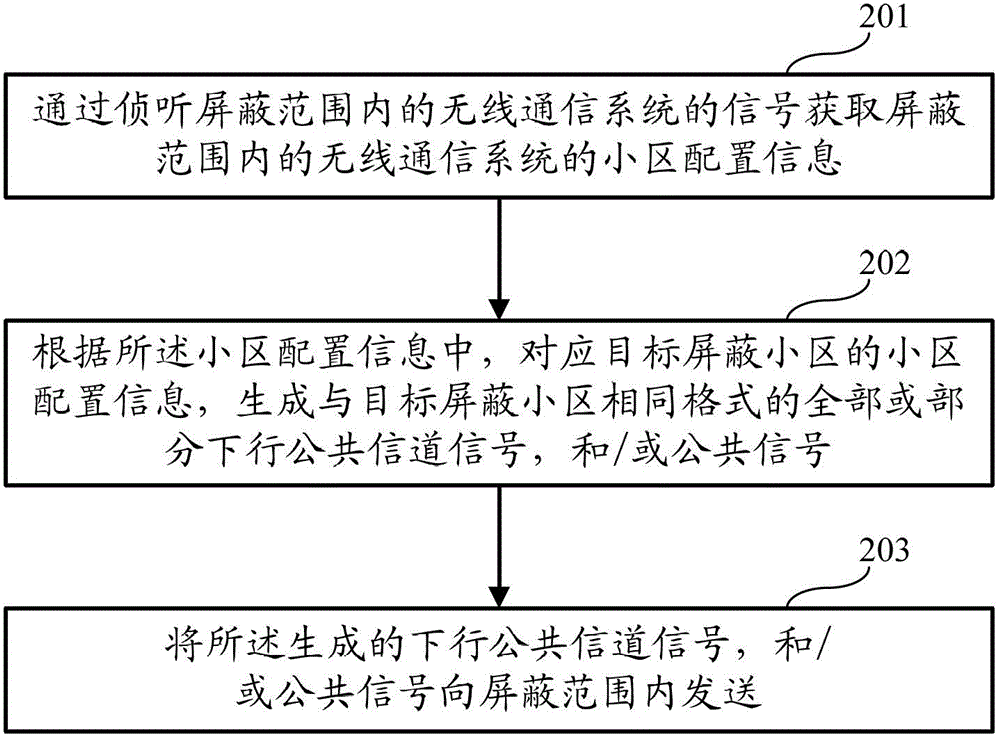Method, device and system for signal shielding of wireless communication system
A wireless communication system and signal shielding technology, applied in the field of communication, can solve problems such as difficulty in determining the interference frequency range, affecting normal communication of the wireless communication system, base station interference, etc.
- Summary
- Abstract
- Description
- Claims
- Application Information
AI Technical Summary
Problems solved by technology
Method used
Image
Examples
Embodiment 1
[0113] Embodiment 1. The signal interception process of the long-term evolution (LTE) system, such as image 3 shown, including:
[0114] Step 301, carrier frequency detection; acquiring carrier frequency.
[0115] Step 302, symbol timing detection.
[0116] Step 303, cell ID identification within the group.
[0117] Step 304, wireless frame timing detection; acquiring frame timing information.
[0118] Step 305, cell ID group identification; obtaining cell ID group information.
[0119] Step 306, physical broadcast channel (PBCH) multi-antenna group identification; acquiring antenna information.
[0120] Step 307, identifying the length of the cyclic prefix (CP) of the subframe where the PBCH is located; acquiring CP length information.
[0121] Step 308, time and frequency synchronization; performing time and frequency synchronization with the wireless communication system.
[0122] Step 309, read system information, including information such as system bandwidth, Phys...
Embodiment 2
[0124] Embodiment 2, signal interception process of wideband code division multiple access (WCDMA) system, such as Figure 4 shown, including:
[0125] Step 401, carrier frequency detection; acquiring carrier frequency.
[0126] Step 402, time slot synchronization;
[0127] Step 403, scrambling code group identification and frame synchronization; obtaining scrambling code group information.
[0128] Step 404, scrambling code identification; acquiring scrambling code information.
[0129] Step 405, read system information.
[0130] The information to be obtained in steps 401 and 402 can be obtained using the primary synchronization channel (P-SCH), the information to be obtained in step 403 can be obtained using the S-SCH channel, and the information to be obtained in steps 404 and 405 can be obtained using the primary synchronization channel (P-SCH). Control Physical Channel (P-CCPCH) acquisition.
Embodiment 3
[0131] Embodiment 3, the signal interception process of code division multiple access and its evolution (CDMA1X or EVDO) system is as follows Figure 5 shown, including:
[0132] Step 501, carrier frequency detection; acquiring carrier frequency.
[0133] Step 502, identifying the offset of the local pseudo-random (PN) sequence; acquiring PN sequence offset information.
[0134] Step 503, time synchronization, which can be synchronized by obtaining long code state (LC_STATE), system time (SYS_TIME), pilot offset (PILOT_PN) and other parameters;
[0135] Step 504, read system information.
[0136] The information to be obtained in steps 501 and 502 can be obtained using the forward pilot channel (F-PICH), the information to be obtained in step 503 can be obtained using the forward synchronization (F-SYNC) signal, and the information to be obtained in step 504 It can be acquired using the Forward Paging Channel (F-PCH), Forward Broadcast Control Channel (F-BCCH), and Forward ...
PUM
 Login to View More
Login to View More Abstract
Description
Claims
Application Information
 Login to View More
Login to View More - R&D
- Intellectual Property
- Life Sciences
- Materials
- Tech Scout
- Unparalleled Data Quality
- Higher Quality Content
- 60% Fewer Hallucinations
Browse by: Latest US Patents, China's latest patents, Technical Efficacy Thesaurus, Application Domain, Technology Topic, Popular Technical Reports.
© 2025 PatSnap. All rights reserved.Legal|Privacy policy|Modern Slavery Act Transparency Statement|Sitemap|About US| Contact US: help@patsnap.com



